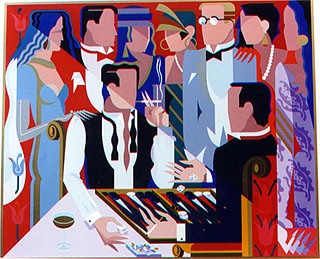|
| Magriel's NYT Columns |
 Often in backgammon a relatively experienced player will look ahead several moves, foresee danger and take measures to counteract it. However, backgammon is a deceptive game, and sometimes these apparent measures prove ineffective.
Often in backgammon a relatively experienced player will look ahead several moves, foresee danger and take measures to counteract it. However, backgammon is a deceptive game, and sometimes these apparent measures prove ineffective.
At the Thanksgiving invitational tournament in Sarasota, Fla., a situation of this type came up. In the diagrammed position, Black, a local player, had closed out two of White’s men and was well on his way to winning the game and a possible gammon.
His only problem was to extricate his back man on the 23-point from behind White’s broken 5-point prime. To do this, Black needed to roll a 5, the only number with which to escape. He was concerned that if he failed to roll a 5 in the next few turns, he would be forced to continue moving forward with his spare men (on the 5- and 15-points), and eventually break up his home board.
|
| Black to play 4-3. |
Black’s tactics, however, were misguided: they were a result of a commonplace optical illusion. In fact, every move Black makes will leave him exactly the same amount of time for his two spare men. With every play, he must move forward a total of 7 pips; and with every play he will have exactly the number of pips left over to move his spare men. Therefore the efficacy of moving a man to the 1-point to gain time is illusory.
|
|
|
Further, the gammon in this situation is almost a 50–50 proposition, and any slight delay bearing off may well cost Black his chance for a double game.
Rollout
 Tom Keith 2013 |
|
Money play White owns 2-cube Black rolls 4-3 1296 games with VR Checker play: 2-ply Cube play: 3-ply Red |
| 4-3: | Game | G | BG | Equity | ||||
| 1 | 15/8 |
W L |
.8033 .1967 |
.4483 .0178 |
.0060 .0006 | +0.9651 |

| (b) |
| 2 | 15/11, 5/2 |
W L |
.7939 .2061 |
.4326 .0200 |
.0052 .0007 | +0.9230 | (0.0421) | |
| 3 | 15/12, 5/1 |
W L |
.7919 .2081 |
.4308 .0213 |
.0051 .0007 | +0.9167 | (0.0484) | (a) |

|
|

